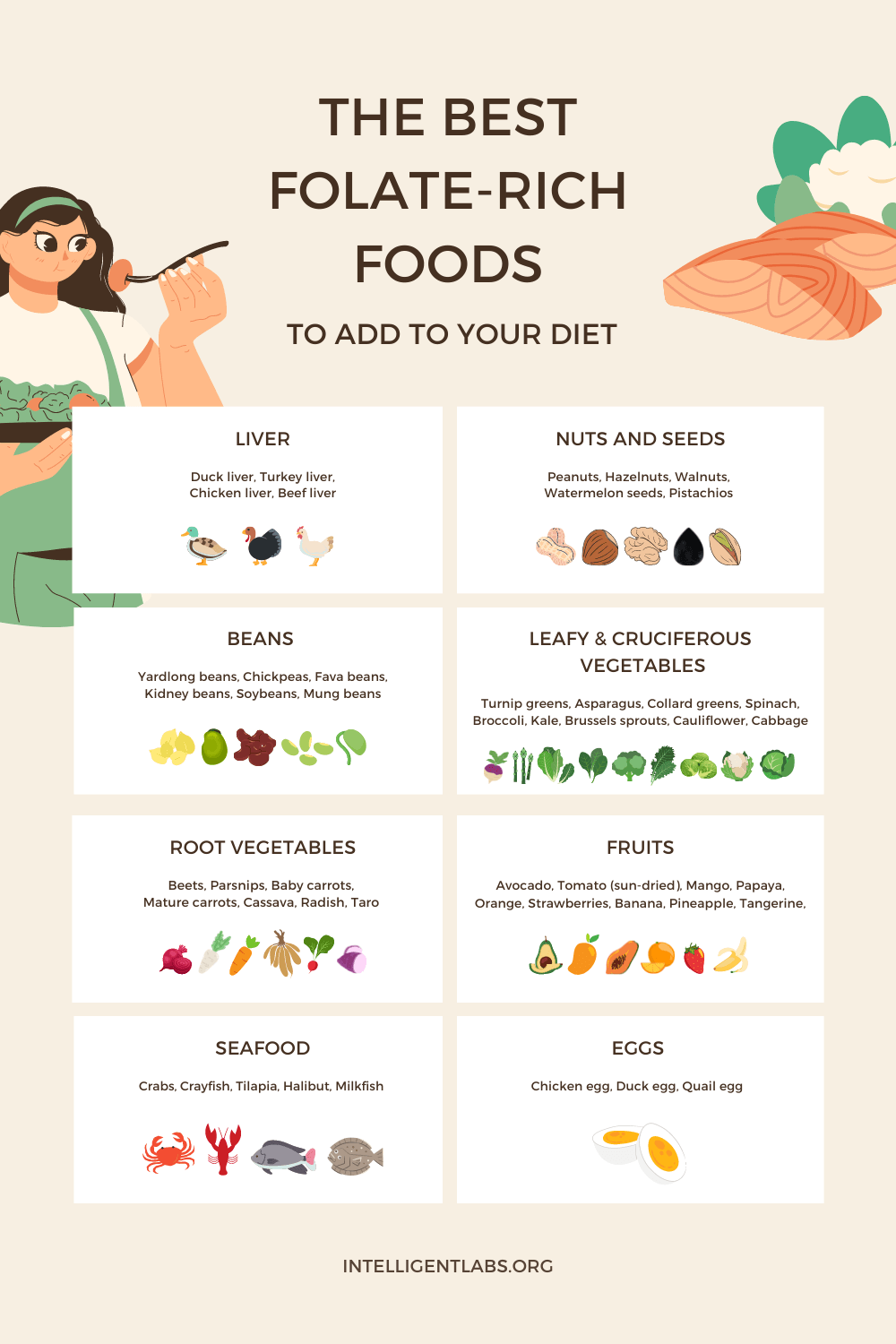Folate is key for energy, red blood cells, and healthy cell growth. You’ll find it in all sorts of whole foods, especially greens, beans, and liver. But if your body struggles to process folate (like with the MTHFR gene variant), a bioavailable supplement like 5-MTHF can help. Still, food is the best place to start. In this guide, we’ll show you the top folate-rich foods (organized into easy categories) and how to make the most of them.
Table of Contents
Why eat folate-rich foods?
Folate is the form of Vitamin B9 naturally found in food. Other forms of B9 are:1
- Folic acid – this is the synthetic form
- 5-MTHF – this is the bioactive form that both folate and folic acid get converted to in the body
Folate is required for essential body functions, such as:
- Energy production and fatigue reduction
- Immune system function
- Cell division and blood formation
- Amino acid synthesis and homocysteine metabolism
- Production of important neurotransmitters
For women, eating foods rich in folate for pregnancy is an absolute must because this vitamin is essential for prenatal health. Increasing folate intake at least 3 months before pregnancy is recommended to help prevent neural tube defects in babies.2
The Best Folate-Rich Foods To Add To Your Diet
We will be focusing only on foods naturally rich in folate, so you will not see any folic acid-enriched foods below. Take a look at the best foods you can consume if you’re looking to enrich your diet with folate:

Liver
Organ meat may not be to everyone’s liking, but if you want the best bang for your buck in terms of folate content, then liver is a must-eat. Liver is one of the healthiest foods on the planet.
Pro tip: To make liver more palatable, soak it in a bowl of milk for about half an hour. This removes the bitter flavor and brings out its more pleasant taste.
Nuts and seeds
Nuts and seeds may have a higher fat and calorie content than other foods we listed. But contrary to popular belief, it’s not a bad thing at all! These tiny morsels contain good types of fat, such as monounsaturated and polyunsaturated fats, which have beneficial effects on cardiovascular health.3
Beans
Beans are well-known for their fiber and protein content, especially in vegan and vegetarian communities. They are also naturally gluten-free, making them an excellent option for those with celiac disease.4 Moreover, they’re economical as refrigeration isn’t necessary. They can last in the pantry for months!
While beans are excellent sources of folate, fiber, and other beneficial plant compounds, eating too much can give you gas, bloating, and stomach pain. Soaking the beans for several hours may help reduce the gassy side effects.5
Leafy and cruciferous vegetables
A basic requirement for a healthy, well-rounded diet, leafy and cruciferous vegetables are rich in many nutrients, including folate. They’re also low in calories, so you can eat more than one serving and not worry about gaining extra weight.
A daily serving of leafy greens can help slow down cognitive decline associated with ageing.6 For best results, however, try to eat different kinds of these folate-rich vegetables. Doing so may help reduce the risk of cardiovascular disease.7
Root vegetables
As the name suggests, this type of vegetable grows underground. They’re rich in nutrients too, but the downside is that they’re also relatively high in starch.8 Anyone doing low carb or keto may need to minimize consumption or avoid this veggie group altogether.
Fruits
Fruits are delicious and nutritious, and often make the perfect snack or dessert. They’re low in calories plus they’re packed full of antioxidants, such as Vitamin C. This is important because the body doesn’t produce Vitamin C; we must get it from our diet.9
Seafood
Seafood is a great source of protein and polyunsaturated fatty acids, such as the omega-3 fatty acids DHA and EPA. Other bioactive components found in seafood are amino acids, phospholipids, and of course, vitamins and minerals.10
Eggs
Eggs are a natural source of many nutrients, proteins, and healthy fats. Egg yolks, in particular, contain most of the nutrients compared to egg whites.
What’s the best way to cook folate-rich foods?
Unfortunately, folate is easily destroyed with improper handling and cooking techniques. For instance, steaming spinach and broccoli is fine, but boiling can eliminate approximately half the folate content! That said, there is no single best way to cook folate-rich foods. Far too many factors influence folate retention (and loss) in various foods.11
Are you getting enough folate via food intake?
As you’ve learned in this blog post, there are many food sources of folate. But since it’s also easily destroyed, the total amount of folate that makes it to your gut and liver is drastically reduced. Moreover, only half of the folate intake from food is absorbed in the body.12

To increase your folate intake, you may eat more folic acid-enriched foods or take folic acid supplements. Folic acid is more stable than folate and is better absorbed, too. Sounds great, right? But there’s the thing – if you don’t track your folic acid intake, it can lead to a buildup of unmetabolized folic acid in the blood.13
Therefore, for best results, we recommend you take 5-MTHF, the bioactive form of Vitamin B9. This is the main form found in blood and cord serum; it does not need any conversions like natural folate and folic acid.14
Do check out our Intelligent Labs 5-MTHF activated folic acid supplements, which come in 2 different doses – 1mg and 5mg. Do try out the product and see how you like it!
💬 Something on your mind? Share your thoughts in the comments. We love hearing from curious minds.
📩 And while you’re here, join our newsletter for more smart stuff (and secret perks)!
References
- Folate, Fact Sheet for Health Professionals, from: https://ods.od.nih.gov/factsheets/Folate-HealthProfessional/ ↩︎
- Folic acid versus 5- methyl tetrahydrofolate supplementation in pregnancy, Giulia Tiso, Daniela Di Martino et al. European Journal of Obstetrics & Gynecology and Reproductive Biology, Volume 253, October 2020, Pages 312-319 ↩︎
- Ros E. Health Benefits of Nut Consumption. Nutrients. 2010; 2(7):652-682. ↩︎
- All About Beans Nutrition, Health Benefits, Preparation and Use in Menus, from North Dakota State University, https://www.ndsu.edu/agriculture/extension/publications/all-about-beans-nutrition-health-benefits-preparation-and-use-menus ↩︎
- Soaking and cooking modify the alpha-galacto-oligosaccharide and dietary fibre content in five Mediterranean legumes, Sondos Njoumi, Marie Josephe Amiot et al. Pages 551-561 | Received 12 Sep 2018, Accepted 31 Oct 2018, Published online: 07 Jan 2019 ↩︎
- Morris MC, Wang Y, Barnes LL, Bennett DA, Dawson-Hughes B, Booth SL. Nutrients and bioactives in green leafy vegetables and cognitive decline: Prospective study. Neurology. 2018;90(3):e214-e222. ↩︎
- Pollock RL. The effect of green leafy and cruciferous vegetable intake on the incidence of cardiovascular disease: A meta-analysis. JRSM Cardiovasc Dis. 2016;5:2048004016661435. Published 2016 Aug 1. ↩︎
- The pros and cons of root vegetables, Staying Healthy, February 15, 2021 ↩︎
- Antioxidant-rich natural fruit and vegetable products and human health, Afam I. O. Jideani, Henry Silungwe et al. Pages 41-67 | Received 05 Aug 2020, Accepted 11 Dec 2020, Published online: 07 Jan 2021 ↩︎
- Seafood Consumption and Components for Health, Ryota Hosomi, Munehiro Yoshida, Kenji Fukunaga, Glob J Health Sci. 2012 May; 4(3): 72–86. ↩︎
- McKillop, D., Pentieva, K., Daly, D., McPartlin, J., Hughes, J., Strain, J., . . . McNulty, H. (2002). The effect of different cooking methods on folate retention in various foods that are amongst the major contributors to folate intake in the UK diet. British Journal of Nutrition, 88(6), 681-688. ↩︎
- Obeid R, Herrmann W. The emerging role of unmetabolized folic acid in human diseases: myth or reality?. Curr Drug Metab. 2012;13(8):1184-1195. ↩︎
- Circulating Unmetabolized Folic Acid: Relationship to Folate Status and Effect of Supplementation, Carolyn Tam, Deborah O’Connor and Gideon Koren, Research Article | Open Access Volume 2012 | Article ID 485179 ↩︎
- Folate, folic acid and 5-methyltetrahydrofolate are not the same thing, Francesco Scaglione, Giscardo Panzavolta, Pages 480-488 | Received 12 Jul 2013, Accepted 13 Sep 2013, Published online: 04 Feb 2014 ↩︎




